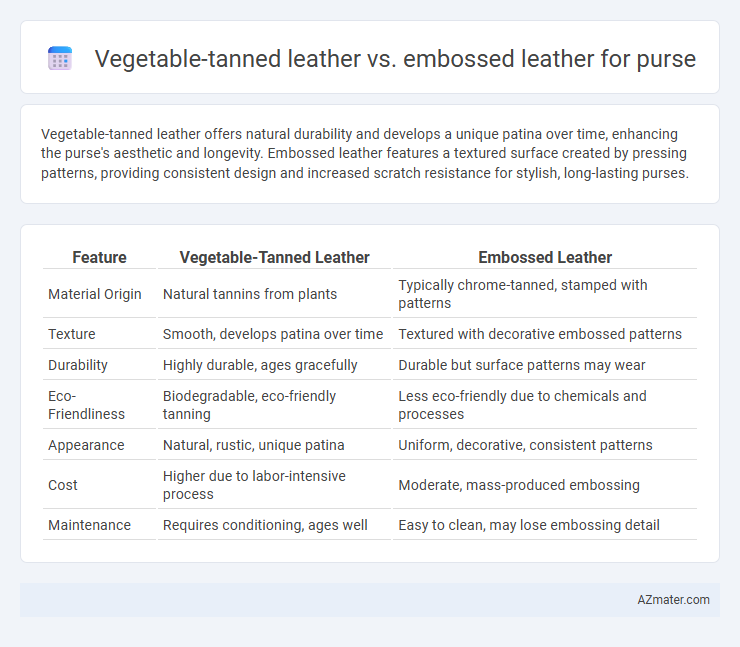Vegetable-tanned leather offers natural durability and develops a unique patina over time, enhancing the purse's aesthetic and longevity. Embossed leather features a textured surface created by pressing patterns, providing consistent design and increased scratch resistance for stylish, long-lasting purses.
Table of Comparison
| Feature | Vegetable-Tanned Leather | Embossed Leather |
|---|---|---|
| Material Origin | Natural tannins from plants | Typically chrome-tanned, stamped with patterns |
| Texture | Smooth, develops patina over time | Textured with decorative embossed patterns |
| Durability | Highly durable, ages gracefully | Durable but surface patterns may wear |
| Eco-Friendliness | Biodegradable, eco-friendly tanning | Less eco-friendly due to chemicals and processes |
| Appearance | Natural, rustic, unique patina | Uniform, decorative, consistent patterns |
| Cost | Higher due to labor-intensive process | Moderate, mass-produced embossing |
| Maintenance | Requires conditioning, ages well | Easy to clean, may lose embossing detail |
Introduction to Vegetable-Tanned and Embossed Leather
Vegetable-tanned leather is crafted using natural tannins from tree bark and plants, resulting in a durable, eco-friendly material that develops a rich patina over time. Embossed leather is created by pressing patterns or textures onto the surface of genuine leather, enhancing aesthetic appeal while maintaining flexibility and strength. Choosing between vegetable-tanned and embossed leather depends on preferences for natural aging and texture versus decorative design and uniformity.
What is Vegetable-Tanned Leather?
Vegetable-tanned leather is a durable and eco-friendly material made using natural tannins derived from tree bark, leaves, and fruits, offering a rich patina that improves with age, ideal for purses seeking longevity and character. This leather type is known for its firmness and ability to develop a unique, personalized appearance over time without chemical treatments. Compared to embossed leather, which is stamped with patterns on chrome-tanned hides, vegetable-tanned leather provides a more natural, breathable texture and environmentally sustainable production process.
What is Embossed Leather?
Embossed leather is a type of leather that has been stamped or pressed with a pattern or texture to mimic the appearance of exotic or expensive materials, enhancing its aesthetic appeal without altering the base leather's natural qualities. Unlike vegetable-tanned leather, which undergoes a natural tanning process using tannins from plant materials to increase durability and develop a rich patina over time, embossed leather primarily focuses on surface design and uniformity. This makes embossed leather ideal for purses seeking stylish and consistent textures, while vegetable-tanned leather offers a more natural feel and long-lasting strength.
Key Differences Between Vegetable-Tanned and Embossed Leather
Vegetable-tanned leather is crafted through a natural tanning process using tannins from plant materials, resulting in a durable, breathable, and environmentally friendly material that develops a unique patina over time. Embossed leather is created by pressing patterns or textures onto the leather surface, which can be either genuine or synthetic, enhancing aesthetic appeal without affecting the underlying material's durability. Key differences lie in the tanning process, texture, and aging characteristics: vegetable-tanned leather offers natural variations and long-lasting strength, whereas embossed leather prioritizes design uniformity and surface customization.
Durability: Which Leather Lasts Longer in Purses?
Vegetable-tanned leather, known for its natural aging process and sturdy fiber structure, typically lasts longer in purses due to its resistance to wear and tear over time. Embossed leather, while aesthetically versatile with patterns pressed into its surface, may experience faster surface degradation and peeling, especially in high-friction areas. The durability advantage of vegetable-tanned leather makes it the preferred choice for consumers seeking long-lasting purses with a classic, natural look.
Aesthetics and Texture Comparison
Vegetable-tanned leather showcases a rich, natural patina that deepens over time, offering a unique, smooth texture with subtle grain variations that enhance the purse's handcrafted appeal. Embossed leather features a consistent, patterned surface mimicking exotic skins or geometric designs, providing a visually striking aesthetic with a firmer texture and uniform feel. The choice between these leathers impacts the purse's tactile experience and visual depth, with vegetable-tanned leather emphasizing organic elegance, while embossed leather highlights bold, graphic detail.
Environmental Impact: Sustainability Factors
Vegetable-tanned leather uses natural tannins from plant materials, leading to a biodegradable and less chemically intensive process that minimizes environmental pollution. Embossed leather often relies on chemical treatments and synthetic coatings to achieve its texture, which can hinder biodegradability and contribute to higher ecological footprints. Sustainable purse production favors vegetable-tanned leather due to its lower energy consumption, reduced toxic waste, and overall smaller environmental impact.
Care and Maintenance Tips for Each Leather Type
Vegetable-tanned leather requires gentle cleaning with a damp cloth and periodic application of natural oils to maintain its durability and develop a rich patina over time. Embossed leather benefits from regular dusting and careful wiping with a soft cloth, avoiding excessive moisture to prevent damage to the textured surface. Both types should be stored in a cool, dry place away from direct sunlight to preserve their appearance and extend the life of the purse.
Cost Considerations and Value for Money
Vegetable-tanned leather purses typically cost more due to the labor-intensive, eco-friendly tanning process, offering long-term durability and unique patina that enhance value for money. Embossed leather purses are generally more affordable, featuring surface patterns pressed into lower-grade hides that provide style variety but may wear faster and lack the natural aging qualities. Choosing between the two depends on prioritizing initial cost versus investment in leather longevity and aesthetic evolution.
Which Leather is Best for Your Purse?
Vegetable-tanned leather offers natural durability, ages beautifully developing a rich patina over time, making it ideal for purses that gain character with use. Embossed leather provides a consistent texture and design, resistant to scratches and wear, suitable for fashion purses needing a polished, uniform appearance. Choosing between them depends on whether you prioritize long-lasting authenticity and classic aging (vegetable-tanned) or stylish, low-maintenance texture with precise patterns (embossed).

Infographic: Vegetable-tanned leather vs Embossed leather for Purse
 azmater.com
azmater.com